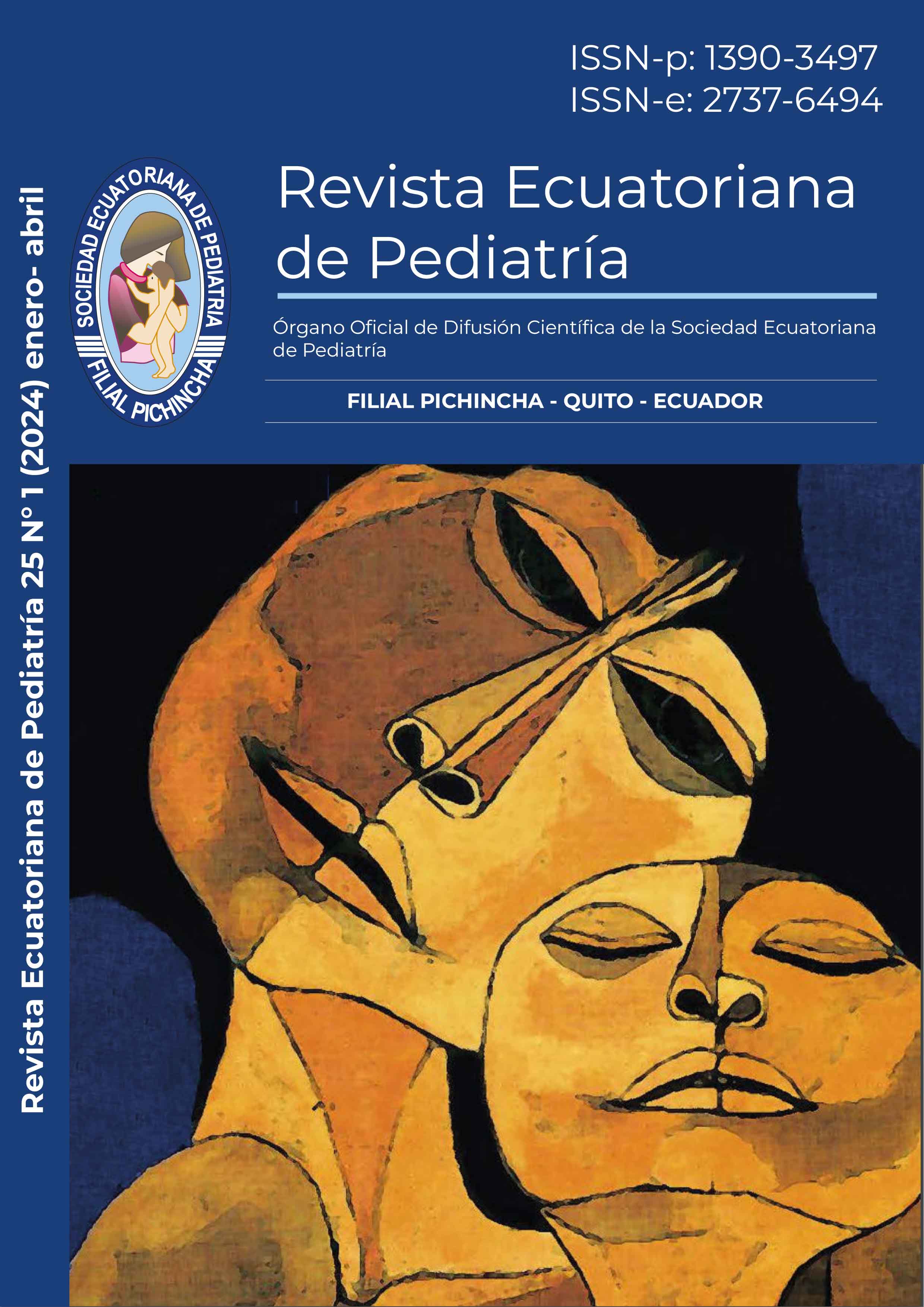Clinical characteristics and outcomes at discharge of neonates with mild asphyxia treated at the University Hospital of Bogotá 2015-2022
Main Article Content
Abstract
Introduction: The management of neonatal hypoxic-ischemic encephalopathy with the use of therapeutic hypothermia has managed to reduce mortality and neurological sequelae in newborns with moderate or severe perinatal asphyxia. However, not all cases have an indication for the prescription of therapy with current criteria: mild asphyxia is one of these. The objective of the present investigation was to describe the characteristics and early clinical outcomes of the discharge of neonates with mild asphyxia treated in the HUSI newborn unit during the study period. Methods: observational, descriptive study of a historical cohort. Population: Neonates with mild asphyxia treated at the San Ignacio Hospital in the city of Bogotá, during the study period. Measurement: Data from the medical history corresponding to clinical sociodemographic variables and clinical outcomes were recorded at discharge. Results: A total of 59 newborns with criteria for mild neonatal asphyxia treated at San Ignacio University Hospital during the study period were included. Regarding early clinical findings, we found that 64.4% of newborns required oxygen support. One patient had a seizure, 25 patients had pulmonary hypertension by echocardiogram, intraparenchymal cerebral hemorrhage in 2 cases, and feeding disorders in 5 newborns. Conclusion: Patients with mild perinatal asphyxia had significant complications in the neonatal period, which put them patients at high neurological risk.
Downloads
Article Details

This work is licensed under a Creative Commons Attribution-NonCommercial-ShareAlike 4.0 International License.
References
Ulloa-Ricárdez A, Meneses-Roldán E, Del Castillo-Medina A. Niveles de pH y lactato en sangre de cordón umbilical en recién nacidos con asfixia perinatal. Repercusión clínica. Rev del Hosp Juárez México [Internet]. 2016;83(3):80–5. Disponible en: https://www.minsalud.gov.co/sites/rid/Lists/BibliotecaDigital/RIDE/INEC/IETS/GPC_Ptes_Asfix.pdf
Piñeros JG, Troncoso G, Serrano C, Espinosa E. Diagnóstico, Manejo, monitoreo y seguimiento del recién nacido con asfixia perinatal, Encefalopatía, Hipóxico Isquémica (EHI), e Hipotermia Terapeutica (HT) [Internet]. 2021. Disponible en: https://ascon.org.co/wp-content/uploads/2021/02/CONSENSO-NEUROLOGIA-Y-NEONATOLOGIA1.pdf
Chalak LF, Nguyen K-A, Prempunpong C, Heyne R, Thayyil S, Shankaran S, et al. Prospective research in infants with mild encephalopathy identified in the first six hours of life: neurodevelopmental outcomes at 18–22 months. Pediatr Res [Internet]. 2018;84(6):861–8. Disponible en: https://doi.org/10.1038/s41390-018-0174-x
Dupont TL, Chalak LF, Morriss MC, Burchfield PJ, Christie L, Sánchez PJ. Short-term outcomes of newborns with perinatal acidemia who are not eligible for systemic hypothermia therapy. J Pediatr. 2013;162(1):35–41.
Centro Nacional de Investigación en Evidencia, y Tecnologías en Salud C. Guía de práctica clínica del recién nacido con asfixia perinatal. Bogotá, D.C; 2013.
American Heart Association. Actualización de las guías de la American Heart Association sobre reanimación cardiopulmonar y cuidados cardiovasculares urgentes [Internet]. 2020. Disponible en: https://www.ahajournals.org/doi/10.1161/CIR.0000000000000918
Martínez-Biarge M, Blanco D, García-Alix A, Salas S. Seguimiento de los recién nacidos con encefalopatía hipóxico-isquémica. An Pediatría [Internet]. 2014;81(1):52.e1-52.e14. Disponible en: https://www.analesdepediatria.org/es-seguimiento-recien-nacidos-con-encefalopatia-articulo-S1695403313003330
Conway JM, Walsh B, Boylan GB, Murray D. Mild hypoxic ischaemic encephalopathy and long term neurodevelopmental outcome - A systematic review. Early Hum Dev. el 1 de febrero de 2018;120.
Reiss J, Sinha M, Gold J, Bykowski J, Lawrence SM. Outcomes of Infants with Mild Hypoxic Ischemic Encephalopathy Who Did Not Receive Therapeutic Hypothermia. Biomed hub. 2019;4(3):1–9.
Lally PJ, Montaldo P, Oliveira V, Soe A, Swamy R, Bassett P, et al. Magnetic resonance spectroscopy assessment of brain injury after moderate hypothermia in neonatal encephalopathy: a prospective multicentre cohort study. Lancet Neurol. enero de 2019;18(1):35–45.
Páez G, Jaramillo L, Franco C, Arregoces L. Estudio sobre el modo de gestionar la salud en Colombia [Internet]. Bogotá, D.C; 2013. Disponible en: https://www.minsalud.gov.co/sites/rid/Lists/BibliotecaDigital/RIDE/DE/AS/gestionar la salud en Colombia.pdf
Ferriero DM. Neonatal brain injury. N Engl J Med. noviembre de 2004;351(19):1985–95.
Thompson CM, Puterman AS, Linley LL, Hann FM, van der Elst CW, Molteno CD, et al. The value of a scoring system for hypoxic ischaemic encephalopathy in predicting neurodevelopmental outcome. Acta Paediatr. julio de 1997;86(7):757–61.
Salama H, Access O, Saeed A, Moussa A, Qubasi M, Al S, et al. Outcomes for Newborns with Mild Hypoxic-Ischemic Encephalopathy: A Retrospective Study. Ann Pediatr. el 10 de septiembre de 2021;4.

